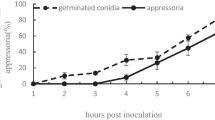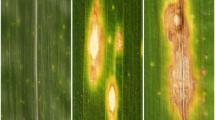Abstract
Stem rot, caused by Sclerotinia sclerotiorum (Lib.) de Bary, is one of the major diseases of oilseed rape worldwide. The infection process of S. sclerotiorum in leaves and stems and the alterations of cell wall components in the infected host tissues were examined by electron microscopy and cytochemical labelling techniques. One day after inoculating (dai) leaves and stems with fungal grown agar disks, dense mycelial networks were usually formed on the inoculated tissues. Then, the infection cushions of different size were developed. Mucilage produced by the pathogen covered mycelium and infection cushions. Hyphae forming infection cushions were often flattened and increased in diameter. After removing the infection cushions, the diameters of the numerous pores through which penetration pegs had entered the cuticle of leaves and stems were small and had almost the same diameter. Penetration of leaves and stems occurred 2 and 3 dai, respectively. Small changes in cuticle were observed. After penetration, hyphae of the pathogen extended between the cuticle and epidermal cell walls as well as inside the epidermal cell walls. Then inter- and intra-cellularly spreading hyphae were observed in the hemi- and ultra-thin sections by light- and transmission electron microscopy, 5 dai. Hyphae also colonized xylem and phloem. During colonization marked alterations in the host tissues were detected, including disorganization of cytoplasm, cell organelles, disintegration of cell walls and collapse of host cells. The enzyme- and immunogold-labelling investigations showed obvious degradation of cellulose, xylan and pectin in the host cell walls of infected tissues. The degradation of cell wall components suggests that the pathogen may secrete cell wall degrading enzymes (Cwdes) such as cellulases, xylanases and pectinases during infection and spreading in the oilseed rape tissues.
Zusammenfassung
Die Weißstängeligkeit, verursacht durch Sclerotinia sclerotiorum (Lib.) de Bary, ist weltweit eine der bedeutendsten Krankheiten an Raps. Der Infektionsprozess an Blättern und Stängeln sowie Veränderungen der Zellwandkomponenten in infizierten Wirtsgeweben wurde mit Hilfe der Elektronen-mikroskopie und cytochemischen Markierungstechniken untersucht. Einen Tag nach Inokulation (dai) der Blätter und Stängel mit pilzbewachsenen Agarscheiben entwickelte sich ein dichtes Myzel auf den inokulierten Geweben. Anschlie-ßend bildeten sich Infektionskissen unterschiedlicher Größe. Das vom Pathogen produzierte Mucigel umgab Hyphen und Infektionskissen. Infektionskissen-bildende Hyphen waren oft abgeflacht und wiesen einen größeren Durchmesser auf. Nach Entfernung der Infektionskissen zeigte sich, dass die zahlreichen Poren, durch die Penetrationshyphen in die Kutikula der Blätter und Stängel eingedrungen waren, einen geringen und einheitlichen Durchmesser aufwiesen. Blätter und Stängel wurden 2 bzw. 3 Tage nach Inokulation penetriert. Geringe Veränderungen an der Kutikula wurden beobachtet. Nach der Penetration breiteten sich die Hyphen zunächst subkutikulär und innerhalb der Epidermiszellwände aus. Die sich anschließend inter- und intrazellulär ausbreiten-den Hyphen wurden 5 dai in Hemi- und Ultradünnschnitten mit dem Licht- und Transmissionselektronenmikroskop untersucht. Die Hyphen besiedelten ebenfalls Xylem und Phloem. In den befallenen Geweben wurden deutliche Veränderungen wie Desorganisation der Zellwände und Kollaps der Wirtszellen nachgewiesen. Die Studien der Enzym- und Immuno-goldmarkierung ergaben deutliche Abbauerscheinungen von Zellulose, Xylan und Pektin in den Zellwänden infizierter Gewebe. Der Abbau der Zellwandkomponenten deutet an, dass S. sclerotiorum imstande ist, Zellwand-abbauende Enzyme wie Zellulasen, Xylanasen und Pektinasen in Geweben der Rapspflanzen auszuscheiden.
Similar content being viewed by others
Literature
Abawi, G.S., F.J. Polach, W.T. Molin, 1975: Infection of bean by ascospores of Whetzelinia sclerotiorum. Phytopathology 65, 673–678.
Bateman, D.F., S.V. Beer, 1965: Simultaneous production and synergistic action of oxalic acid and polygalacturonase during pathogenesis by Sclerotium rolfsii. Phytopathology 55, 204–211.
Berg, R.H., 1990: Cellulose and xylan in the interface capsule in symbiotic cells of actinorhizae. Protoplasma 159, 35–43.
Boland, G.J., R. Hall, 1994: Index of plant hosts of Sclerotinia sclerotiorum. Can. J. Plant Pathol. 16, 247–252.
Cotton, P., Z. Kasza, C. Bruel, C. Rascle, M. Fèvre, 2003: Ambient pH controls the expression of endopolygalacturonase genes in the necrotrophic fungus Sclerotinia sclerotiorum. FEMS Microbiol. Lett. 227, 163–169.
De Bary, A., 1887: Comparative Morphology and Biology of the Fungi. Mycetozoa and Bacteria. Clarendon Press, Oxford, UK.
Donaldson, P.A., T. Anderson, B.G. Lane, A.L. Davidson, D.H. Simmonds, 2001: Soybean plants expressing an active oligomeric oxalate oxidase from the wheat gf-2.8 (germin) gene are resistant to the oxalate-secreting pathogen Sclerotinia sclerotiorum. Physiol. Mol. Plant Pathol. 59, 297–307.
Favaron, F., L. Sella, R. D’ovidio, 2004: Relationships among endo-polygalacturonase, oxalate, pH and plant polygalacturonase-inhibiting protein (PGIP) in the interaction between Sclerotinia sclerotiorum and soybean. Mol. Plant-Microbe Interact. 17, 1402–1409.
Fraissinet-Tachet, L., M. Fupèvre, 1996: Regulation by galacturonic acid of pectinolytic enzyme production by Sclerotinia sclerotiorum. Curr. Microbiol. 33, 49–53.
Fraissinet-Tachet, L., R. Reymond-Cotton, M. Fupèvre, 1995: Characterization of a multigene family encoding an endo-po-lygalacturonase in Sclerotinia sclerotiorum. Curr. Microbiol. 29, 96–100.
Frens, G., 1973: Controlled nucleation for the regulation of the particle size in monodispersed gold suspensions. Nature 241, 20–22.
Giesbert, S., H. Lep**, K.B. Tenberge, P. Tudzynski, 1998: The xylanolytic system of Claviceps purpurea cytological evidence for secretion of xylanase in infected rye tissue and molecular characterization of two xylanase genes. Phytopathology 88, 1021–1030.
Godoy, G., J.R. Steadman, M.B. Dickman, R. Dam, 1990: Use of mutants to demonstrate the role of oxalic acid in pathogenicity of Sclerotinia sclerotiorum on Phaseolus vulgaris. Physiol. Mol. Plant Pathol. 37, 179–191.
Hancock, J.G., 1967: Hemicellulose degradation in sunflower hypocotyls infected with Sclerotinia sclerotiorum. Phytopathology 57, 203–206.
Jamaux, I., B. Gelie, C. Lamarque, 1995: Early stages of infection of rapeseed petals and leaves by Sclerotinia sclerotiorum revealed by scanning electron microscopy. Plant Patholo. 44, 22–30.
Jamaux, I., D. Spire, 1994: Development of a polyclonal anti-body-based immunoassay for the early detection of Sclerotinia sclerotiorum in rapeseed petals. Plant Pathol. 43, 847–862.
Jones, D., 1976: Infection of plant tissue by Sclerotinia sclerotiorum: a scanning electron microscope study. Micron 7, 275–279.
Kang, Z., H. Buchenauer, 2000: Ultrastructural and cytochemical studies on cellulose, xylan and pectin degradation in wheat spikes infected by Fusarium culmorum. J. Phytopathol. 148, 263–275.
Kang, Z., I. Zingen-Sell, H. Buchenauer, 2005: Infection of wheat spikes by Fusarium avenaceum and alterations of cell wall components in the infected tissues. Eur. J. Plant Pathol. 111, 19–28.
Kasza, Z., C. Vagvölgyi, M. Fupèvre , P. Cotton, 2004: Molecular characterization and in planta detection of Sclerotinia sclerotiorum endopolygalacturonase genes. Curr. Microbiol. 48, 208–213.
Lumsden, R.D., 1969: Sclerotinia sclerotiorum infection of bean and the production of cellulase. Phytopathology 59, 653–657.
Lumsden, R.D., 1976: Pectolytic enzymes of Sclerotinia sclerotiorum and their localization in infected bean. Can. J. Bot. 54, 2630–2641.
Lumsden, R.D., R.L. Dow, 1973: Histopathology of Sclerotinia sclerotiorum infection of bean. Phytopathology 63, 708–715.
Marciano, P., P. Di Lenna, P. Magro, 1982: Polygalacturonase isoenzymes produced by Sclerotinia sclerotiorum in vivo and in vitro. Physiol. Plant Pathol. 20, 201–212.
Marciano, P., P. Di Lenna, P. Magro, 1983: Oxalic acid, cell wall-degrading enzymes and pH in pathogenesis and their significance in the virulence of two Sclerotinia sclerotiorum isolates on sunflower. Physiol. Plant Pathol. 22, 339–345.
Maxwell, D.P., R.D. Lumdsen, 1970: Oxalic acid production by Sclerotinia sclerotiorum in infected bean and in culture. Phytopathology 60, 1395–1398.
Oliva, C., M. Regente, M. Feldman, L. De la Canal, 1999: Purification and characterization of an endopolygalacturonase produced by Sclerotinia sclerotiorum. Biol. Plant. 42, 609–614.
Riou, C., G. Freyssinet, M. Fèvre, 1991: Production of cell wall-degrading enzymes by the phytopathogenic fungus Sclerotinia sclerotiorum. Appl. Environ. Microbiol. 57, 1478–1484.
Tariq, V.N., P. Jeffries, 1986: Ultrastructure of penetration of Phaseolus spp. by Sclerotinia sclerotiorum. Can. J. Bot. 64, 2909–2915.
Wanyoike, M.W., Z. Kang, H. Buchenauer, 2002: Importance of cell wall degrading enzymes produced by Fusarium graminearum during infection of wheat heads. Eur. J. Plant Pathol. 108, 803–810.
Willetts, H.J., J.A.L. Wong, 1980: The biology of Sclerotinia sclerotiorum, S. trifoliorum and S. minor with emphasis on specific nomenclature. Bot. Rev. 46, 101–165.
Author information
Authors and Affiliations
Corresponding author
Rights and permissions
About this article
Cite this article
Huang, L., Buchenauer, H., Han, Q. et al. Ultrastructural and cytochemical studies on the infection process of Sclerotinia sclerotiorum in oilseed rape. J Plant Dis Prot 115, 9–16 (2008). https://doi.org/10.1007/BF03356233
Received:
Accepted:
Published:
Issue Date:
DOI: https://doi.org/10.1007/BF03356233




